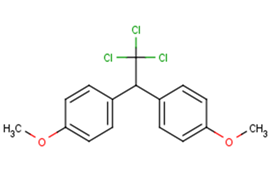
Methoxychlor
CAS No. 72-43-5
Methoxychlor( —— )
Catalog No. M20354 CAS No. 72-43-5
Methoxychlor an organochlorine pesticide is thought to be an endocrine disrupter that affects Ca2 homeostasis and cell viability in different cell models.
Purity : >98% (HPLC)
 COA
COA
 Datasheet
Datasheet
 HNMR
HNMR
 HPLC
HPLC
 MSDS
MSDS
 Handing Instructions
Handing Instructions
| Size | Price / USD | Stock | Quantity |
| 5MG | 33 | In Stock |


|
| 10MG | 45 | In Stock |


|
| 25MG | 61 | In Stock |


|
| 50MG | 104 | In Stock |


|
| 100MG | 156 | In Stock |


|
| 200MG | 235 | In Stock |


|
| 500MG | 447 | In Stock |


|
| 1G | Get Quote | In Stock |


|
Biological Information
-
Product NameMethoxychlor
-
NoteResearch use only, not for human use.
-
Brief DescriptionMethoxychlor an organochlorine pesticide is thought to be an endocrine disrupter that affects Ca2 homeostasis and cell viability in different cell models.
-
DescriptionMethoxychlor an organochlorine pesticide is thought to be an endocrine disrupter that affects Ca2 homeostasis and cell viability in different cell models.
-
In Vitro——
-
In Vivo——
-
Synonyms——
-
PathwayOthers
-
TargetOther Targets
-
RecptorOthers
-
Research Area——
-
Indication——
Chemical Information
-
CAS Number72-43-5
-
Formula Weight345.64
-
Molecular FormulaC16H15Cl3O2
-
Purity>98% (HPLC)
-
Solubility——
-
SMILESCOc1ccc(cc1)C(c1ccc(OC)cc1)C(Cl)(Cl)Cl
-
Chemical Name——
Shipping & Storage Information
-
Storage(-20℃)
-
ShippingWith Ice Pack
-
Stability≥ 2 years
Reference
1.Horng C T Chou C T Tseng H W et al. Effect of Methoxychlor on Ca2? Homeostasis and Apoptosis in HA59T Human Hepatoma Cells[J]. Chin J Physiol 2015 58(1):1-8.
molnova catalog



related products
-
pTH (53-84) (human)
pTH (53-84) (human)
-
7,2,4-Trihydroxy-5-m...
7,2',4'-Trihydroxy-5-methoxy-3-arylcoumarin shows activity in inhibiting prostate specific antigen (PSA) secreted from androgen dependent prostate cancer cell line, LNCaP cells.
-
Dehydrodiconiferyl a...
Dehydrodiconiferyl alcohol 4-O-beta-D-glucopyranoside is a natural product from Ligusticopsis wallichiana (DC) Pimenov & Kljuykov.



 Cart
Cart
 sales@molnova.com
sales@molnova.com


